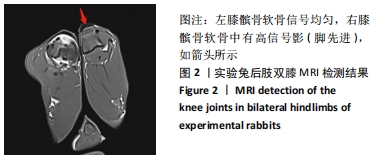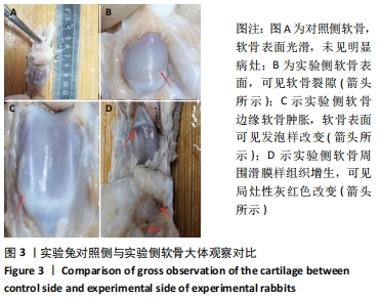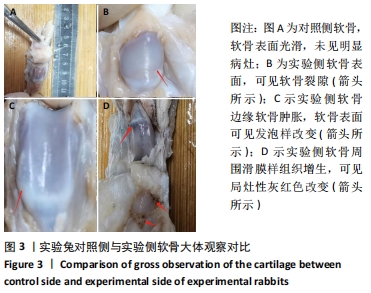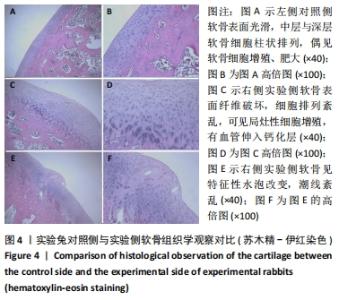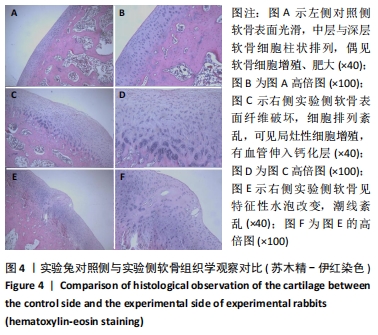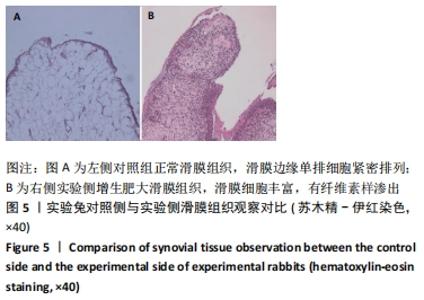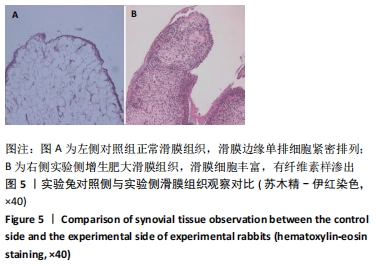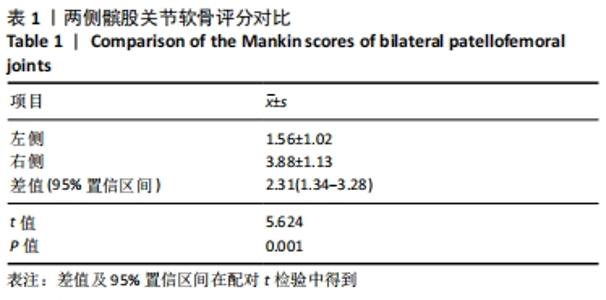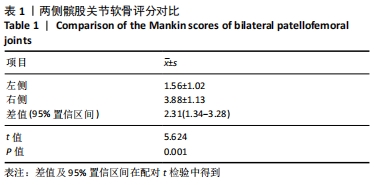Chinese Journal of Tissue Engineering Research ›› 2022, Vol. 26 ›› Issue (14): 2184-2189.doi: 10.12307/2022.481
Previous Articles Next Articles
Effect of uniaxial fatigue exercise on patellofemoral cartilage injury in a rabbit
Tan Xinfang1, Guo Yanxing2, Qin Xiaofei2, Zhang Binqing2, Zhao Dongliang2, Pan Kunkun2, Li Yuzhuo2, Chen Haoyu2
- 1Henan University of Chinese Medicine, Zhengzhou 450000, Henan Province, China; 2Luoyang Orthopedic-Traumatological Hospital of Henan Province (Henan Provincial Orthopedic Hospital), Luoyang 471000, Henan Province, China
-
Received:2021-06-04Revised:2021-06-08Accepted:2021-07-22Online:2022-05-18Published:2021-12-21 -
Contact:Guo Yanxing, Chief physician, Master’s supervisor, Doctoral supervisor, Luoyang Orthopedic-Traumatological Hospital of Henan Province (Henan Provincial Orthopedic Hospital), Luoyang 471000, Henan Province, China -
About author:Tan Xinfang, Master candidate, Henan University of Chinese Medicine, Zhengzhou 450000, Henan Province, China -
Supported by:the National Traditional Chinese Medicine Academic Schools Inheritance Studio Construction Project, No. [2016]227 (to GYX); the Science and Technology Project of Henan Province in 2019, No. 192102310433 (to GYX)
CLC Number:
Cite this article
Tan Xinfang, Guo Yanxing, Qin Xiaofei, Zhang Binqing, Zhao Dongliang, Pan Kunkun, Li Yuzhuo, Chen Haoyu. Effect of uniaxial fatigue exercise on patellofemoral cartilage injury in a rabbit[J]. Chinese Journal of Tissue Engineering Research, 2022, 26(14): 2184-2189.
share this article
Add to citation manager EndNote|Reference Manager|ProCite|BibTeX|RefWorks

进一步进行比较分析,将差值符合正态性分布的进行配对t检验,不符合正态性分布的进行配对秩和检验。左右两侧股骨髁间软骨分别与同侧髌骨软骨进行比较,差异无显著性意义(P=0.830,P=0.142);但左侧髌骨软骨评分与右侧髌骨软骨评分进行比较,左侧髌骨软骨评分1.13±1.13,右侧髌骨软骨评分3.50±1.93,两组数据总体均数相比差异有显著性意义(差值为2.38,95%CI:1.29-3.46,P=0.001);左侧股骨髁间软骨与右侧股骨髁间软骨评分比较,左侧股骨髁间软骨评分1.50±1.20,右侧股骨髁间软骨评分4.25±1.58,两组数据总体均数相比差异有显著性意义(差值为2.75,95%CI:1.59-3.91,P=0.001),见表2。 "

| [1] GARCÍA-TRIANA SA, TORO-SASHIDA MF, LARIOS-GONZÁLEZ XV, et al. The Benefit of Perineural Injection Treatment with Dextrose for Treatment of Chondromalacia Patella in Participants Receiving Home Physical Therapy: A Pilot Randomized Clinical Trial. J Altern Complement Med (New York, N.Y.). 2021;27(1):38-44. [2] DAMGACI L, ÖZER H, DURAN S. Patella-patellar tendon angle and lateral patella-tilt angle decrease patients with chondromalacia patella. Knee Surg Sports Traumatol Arthrosc. 2020;28(8):2715-2721. [3] HONG E, KRAFT MC. Evaluating anterior knee pain. Med Clin North Am. 2014;98(4):697-717. [4] VAN MIDDELKOOP M, VAN DER HEIJDEN RA, SMA B. Characteristics and Outcome of Patellofemoral Pain in Adolescents: Do They Differ From Adults? J Orthop Sports Phys Ther. 2017;47(10):801-805. [5] BERNSTEIN K, SEALES P, MROSZCZYK-MCDONALD A. Selected Musculoskeletal Issues in Adolescents. Prim Care. 2020;47(2):257-271. [6] STEINBERG N, TENENBAUM S, WADDINGTON G, et al. Unilateral and bilateral patellofemoral pain in young female dancers: Associated factors. J Sports Sci. 2020;38(7):719-730. [7] HIEMSTRA LA, KERSLAKE S, KUPFER N, et al. Generalized joint hypermobility does not influence clinical outcomes following isolated MPFL reconstruction for patellofemoral instability. Knee Surg Sports Traumatol Arthrosc. 2019;27(11):3660-3667. [8] FERREIRA AS, MENTIPLAY BF, TABORDA B, et al. Exploring overweight and obesity beyond body mass index: A body composition analysis in people with and without patellofemoral pain. J Sport Health Sci. 2021:S2095-2546(21)00068-5. [9] RHON DI, ROY TC, OH RC, et al. Sex and Mental Health Disorder Differences Among Military Service Members With Patellofemoral Syndrome. J Am Board Fam Med. 2021;34(2):328-337. [10] FONES L, JIMENEZ AE, CHENG C, et al. Trochlear Dysplasia as Shown by Increased Sulcus Angle Is Associated With Osteochondral Damage in Patients With Patellar Instability. Arthroscopy. 2021:S0749-8063(21) 00446-1. [11] AMBRA LF, HINCKEL BB, ARENDT EA, et al. Anatomic Risk Factors for Focal Cartilage Lesions in the Patella and Trochlea: A Case-Control Study. Am J Sports Med. 2019;47(10):2444-2453. [12] DURAN S, CAVUSOGLU M, KOCADAL O, et al. Association between trochlear morphology and chondromalacia patella: an MRI study. Clin Imaging. 2017;41:7-10. [13] CILENGIR AH, CETINOGLU YK, KAZIMOGLU C, et al. The relationship between patellar tilt and quadriceps patellar tendon angle with anatomical variations and pathologies of the knee joint. Eur J Radiol. 2021;139:109719. [14] DAMGACI L, ÖZER H, DURAN S. Patella-patellar tendon angle and lateral patella-tilt angle decrease patients with chondromalacia patella. Knee Surg Sports Rraumatol Arthrosc. 2020;28(8):2715-2721. [15] VAN MIDDELKOOP M, MACRI EM, EIJKENBOOM JF, et al. Are Patellofemoral Joint Alignment and Shape Associated With Structural Magnetic Resonance Imaging Abnormalities and Symptoms Among People With Patellofemoral Pain? Am J Sports Med. 2018;46(13): 3217-3226. [16] GALLINA A, HUNT MA, HODGES PW, et al. Vastus Lateralis Motor Unit Firing Rate Is Higher in Women With Patellofemoral Pain. Arch Phys Med Rehabil. 2018;99(5):907-913. [17] DONG C, LI M, HAO K, et al. Dose atrophy of vastus medialis obliquus and vastus lateralis exist in patients with patellofemoral pain syndrome. J Orthop Surg Res. 2021;16(1):128. [18] DE SIRE A, MAROTTA N, MARINARO C, et al. Role of Physical Exercise and Nutraceuticals in Modulating Molecular Pathways of Osteoarthritis. Int J Mol Sci. 2021;22(11):5722. [19] MESSINA OD, VIDAL WILMAN M, VIDAL NEIRA LF. Nutrition, osteoarthritis and cartilage metabolism. Aging Clin Exp Res. 2019; 31(6):807-813. [20] ÖZDEMIR M, KAVAK RP. Chondromalacia Patella among Military Recruits with Anterior Knee Pain: Prevalence and Association with Patellofemoral Malalignment. Indian J Orthop. 2019;53(6):682-688. [21] HARRIS M, EDWARDS S, RIO E, et al. Nearly 40% of adolescent athletes report anterior knee pain regardless of maturation status, age, sex or sport played. Phys Ther Sport. 2021;51:29-35. [22] GLAVIANO NR, BOLING MC, FRASER JJ. Anterior Knee Pain Risk Differs Between Sex and Occupation in Military Tactical Athletes. J Athle Train. 2021. doi: 10.4085/1062-6050-0578.20. [23] MANKIN HJ, JOHNSON ME, LIPPIELLO L. Biochemical and metabolic abnormalities in articular cartilage from osteoarthritic human hips. III. Distribution and metabolism of amino sugar-containing macromolecules. J Bone Joint Surg. 1981;63(1):131-139. [24] SANCHIS-ALFONSO V, DYE SF. How to Deal With Anterior Knee Pain in the Active Young Patient. Sports Health. 2017;9(4):346-351. [25] SMITH RM, BODEN BP, SHEEHAN FT. Increased Patellar Volume/Width and Decreased Femoral Trochlear Width Are Associated With Adolescent Patellofemoral Pain. Clin Orthop Relat Res. 2018; 476(12):2334-2343. [26] AKSAHIN E, AKTEKIN CN, KOCADAL O, et al. Sagittal plane tilting deformity of the patellofemoral joint: a new concept in patients with chondromalacia patella. Knee Surg Sports Traumatol Arthrosc. 2017; 25(10):3038-3045. [27] FIELD AE, TEPOLT FA, YANG DS, et al. Injury Risk Associated With Sports Specialization and Activity Volume in Youth. Orthop J Sports Med. 2019;7(9):1810917548. [28] 刘文渤, 陈博鉴, 林跃玮, 等. 富血小板血浆治疗膝关节髌骨软化症的短期疗效观察[J]. 实用骨科杂志,2020,26(12):1135-1138,1147. [29] WANG B, LANG Y, ZHANG L. Histopathological changes in the infrapatellar fat pad in an experimental rabbit model of early patellofemoral osteoarthritis. Knee. 2019;26(1):2-13. [30] TAKAHASHI I, MATSUZAKI T, KUROKI H, et al. Induction of osteoarthritis by injecting monosodium iodoacetate into the patellofemoral joint of an experimental rat model. PLOS ONE. 2018;13(4):e196625. [31] BEI MJ, TIAN FM, XIAO YP, et al. Raloxifene retards cartilage degradation and improves subchondral bone micro-architecture in ovariectomized rats with patella baja-induced - patellofemoral joint osteoarthritis. Osteoarthritis Cartilage. 2020;28(3):344-355. [32] 王国良, 孙艳, 唐兆春, 等. 髌骨倾斜对兔髌骨关节软骨损害的实验研究[J]. 中华关节外科杂志(电子版),2014,8(6):775-778. [33] 亓建洪, 黄煌渊, 陈世益, 等. 髌骨倾斜导致髌骨软骨软化实验研究[J]. 中国运动医学杂志,1999,18(1):14-16. [34] KRIEGER EAG, KARAM FC, SODER RB, et al. Prevalence of patellar chondropathy on 3.0 T magnetic resonance imaging. Radiologia Brasileira. 2020;53(6):375-380. [35] 李威, 郭立平, 郭建华, 等. 膝关节相关参数对早期髌骨软化症的诊断价值[J]. 中国骨与关节损伤杂志,2020,35(2):129-133. [36] WENZ W, BREUSCH SJ, GRAF J, et al. Ultrastructural findings after intraarticular application of hyaluronan in a canine model of arthropathy. J Orthop Res. 2000;18(4):604-612. [37] CLEMENTS KM, BALL AD, JONES HB, et al. Cellular and histopathological changes in the infrapatellar fat pad in the monoiodoacetate model of osteoarthritis pain. Osteoarthritis Cartilage. 2009;17(6):805-812. [38] BEDFORD TG, TIPTON CM, WILSON NC, et al. Maximum oxygen consumption of rats and its changes with various experimental procedures. J Appl Physiol Respir Environ Exerc Physiol. 1979;47(6): 1278-1283. [39] LI FH, LI T, AI JY, et al. Beneficial Autophagic Activities, Mitochondrial Function, and Metabolic Phenotype Adaptations Promoted by High-Intensity Interval Training in a Rat Model. Front Physiol. 2018;9:571. |
| [1] | Tan Xinfang, Guo Yanxing, Qin Xiaofei, Zhang Binqing, Zhao Dongliang, Pan Kunkun, Li Yuzhuo, Chen Haoyu. Effect of uniaxial fatigue exercise on patellofemoral cartilage injury in a rabbit [J]. Chinese Journal of Tissue Engineering Research, 2022, 26(在线): 1-6. |
| [2] | Li Huo, Wang Peng, Gao Jianming, Jiang Haoran, Lu Xiaobo, Peng Jiang. Relationship between revascularization and internal microstructure changes in osteonecrosis of the femoral head [J]. Chinese Journal of Tissue Engineering Research, 2022, 26(9): 1323-1328. |
| [3] | Zhu Chan, Han Xuke, Yao Chengjiao, Zhang Qiang, Liu Jing, Shao Ming. Acupuncture for Parkinson’s disease: an insight into the action mechanism in animal experiments [J]. Chinese Journal of Tissue Engineering Research, 2022, 26(8): 1272-1277. |
| [4] | Wu Cong, Jia Quanzhong, Liu Lun. Relationship between transforming growth factor beta1 expression and chondrocyte migration in adult articular cartilage after fragmentation [J]. Chinese Journal of Tissue Engineering Research, 2022, 26(8): 1167-1172. |
| [5] | Wang Baojuan, Zheng Shuguang, Zhang Qi, Li Tianyang. Miao medicine fumigation can delay extracellular matrix destruction in a rabbit model of knee osteoarthritis [J]. Chinese Journal of Tissue Engineering Research, 2022, 26(8): 1180-1186. |
| [6] | Lü Yiyan, Li Hanbing, Ma Xiaoqing, Zhang Han, Zhang Yuhang, Li Genlin. Establishment and characteristic analysis of interior heat and diabetes mouse model using compound factors [J]. Chinese Journal of Tissue Engineering Research, 2022, 26(8): 1187-1193. |
| [7] | Wang Xinmin, Liu Fei, Xu Jie, Bai Yuxi, Lü Jian. Core decompression combined with dental pulp stem cells in the treatment of steroid-associated femoral head necrosis in rabbits [J]. Chinese Journal of Tissue Engineering Research, 2022, 26(7): 1074-1079. |
| [8] | Li Jie, Zhang Haitao, Chen Jinlun, Ye Pengcheng, Zhang Hua, Zhou Bengen, Zhao Changqing, Sun Youqiang, Chen Jianfa, Xiang Xiaobing, Zeng Yirong. Anterior cruciate ligament rupture and patellofemoral joint stability before sagittal and axial measurement using MRI [J]. Chinese Journal of Tissue Engineering Research, 2022, 26(6): 969-972. |
| [9] | Huang Hao, Hong Song, Wa Qingde. Finite element analysis of the effect of femoral component rotation on patellofemoral joint contact pressure in total knee arthroplasty [J]. Chinese Journal of Tissue Engineering Research, 2022, 26(6): 848-852. |
| [10] | Xu Lei, Han Xiaoqiang, Zhang Jintao, Sun Haibiao. Hyaluronic acid around articular chondrocytes: production, transformation and function characteristics [J]. Chinese Journal of Tissue Engineering Research, 2022, 26(5): 768-773. |
| [11] | Lin Xuchen, Zhu Hainian, Wang Zengshun, Qi Tengmin, Liu Limin, Suonan Angxiu. Effect of xanthohumol on inflammatory factors and articular cartilage in a mouse mode of osteoarthritis [J]. Chinese Journal of Tissue Engineering Research, 2022, 26(5): 676-681. |
| [12] | Feng Jianbo, Li Chencheng, Liu Jinyue, Wang Xiaomin, Peng Jiachen. Implantation of Kirschner wire with Staphylococcus aureus biofilm establishes a traumatic osteomyelitis model in rats [J]. Chinese Journal of Tissue Engineering Research, 2022, 26(5): 700-705. |
| [13] | Wang Shihui, Cheng Yang, Zhu Yunjie, Cheng Shaodan, Mao Jianying. Effect of arc edge needle-scalpel therapy on inflammatory factors and histomorphology of the frozen shoulder in rabbit models [J]. Chinese Journal of Tissue Engineering Research, 2022, 26(5): 706-711. |
| [14] | Zhang Tong, Cai Jinchi, Yuan Zhifa, Zhao Haiyan, Han Xingwen, Wang Wenji. Hyaluronic acid-based composite hydrogel in cartilage injury caused by osteoarthritis: application and mechanism [J]. Chinese Journal of Tissue Engineering Research, 2022, 26(4): 617-625. |
| [15] | Zhang Jian, Lin Jianping, Zhou Gang, Fang Yehan, Wang Benchao, Wu Yongchang. Semi-quantitative MRI evaluation of cartilage degeneration in early knee osteoarthritis [J]. Chinese Journal of Tissue Engineering Research, 2022, 26(3): 425-429. |
| Viewed | ||||||
|
Full text |
|
|||||
|
Abstract |
|
|||||

